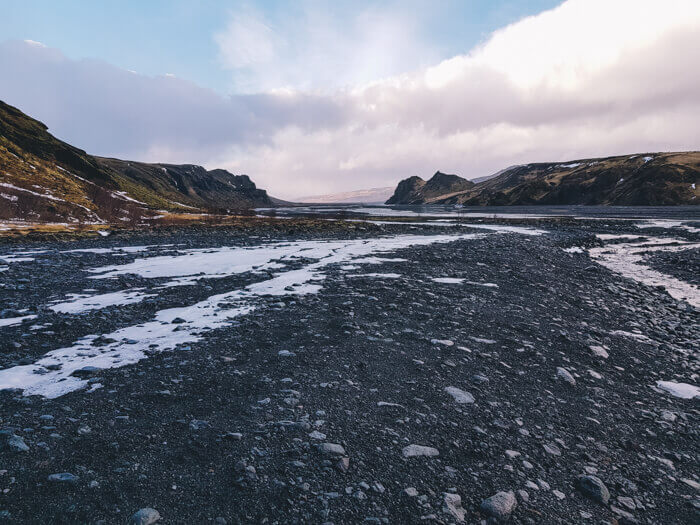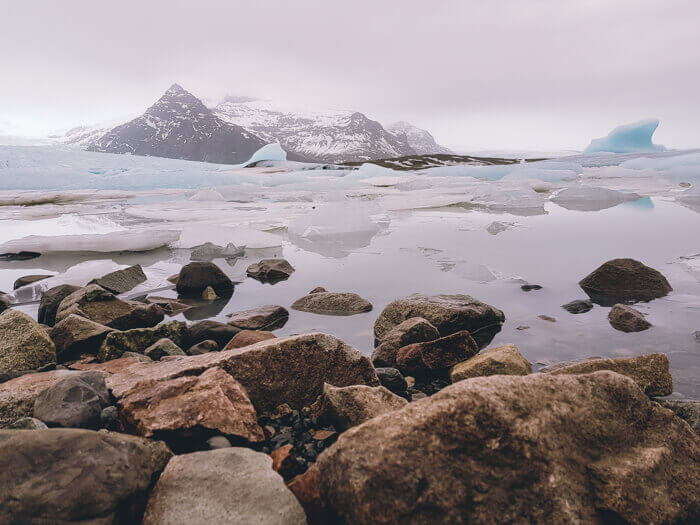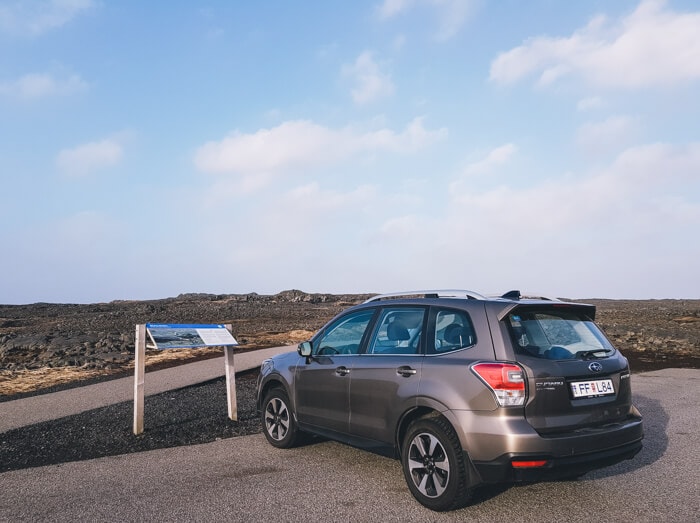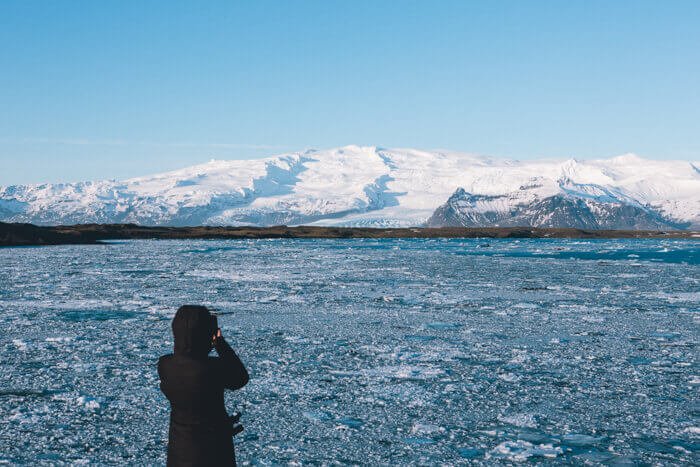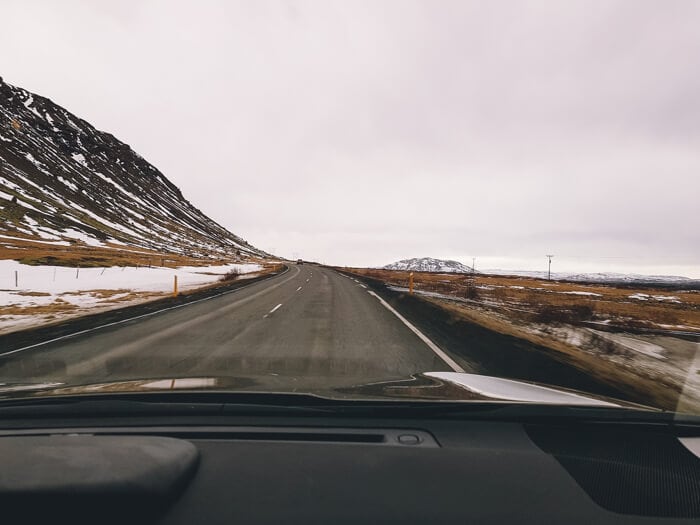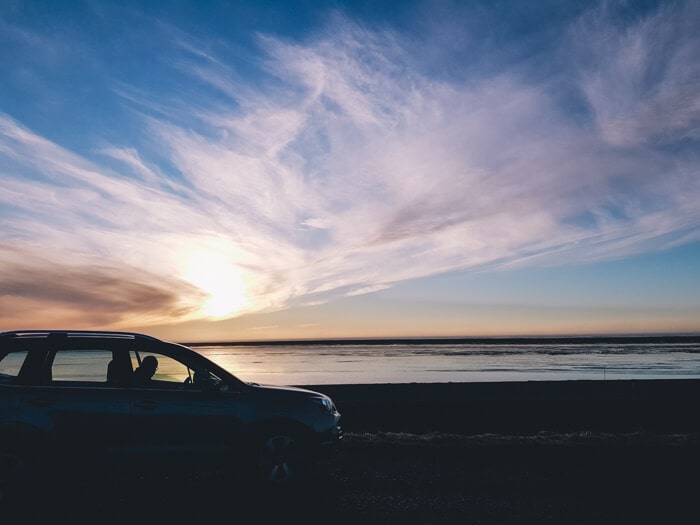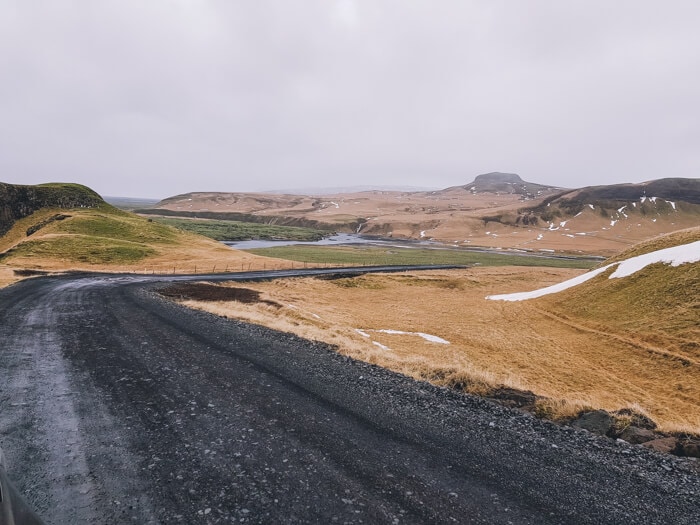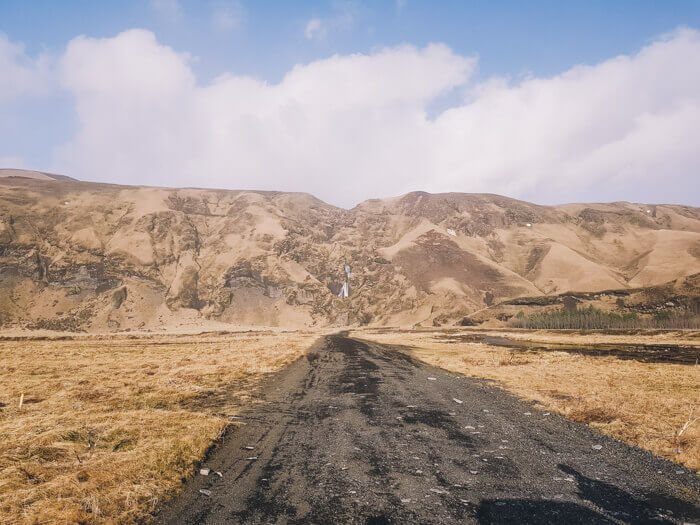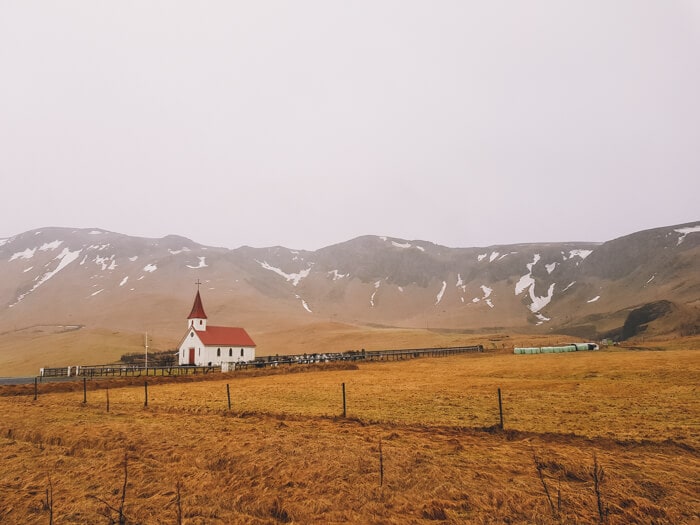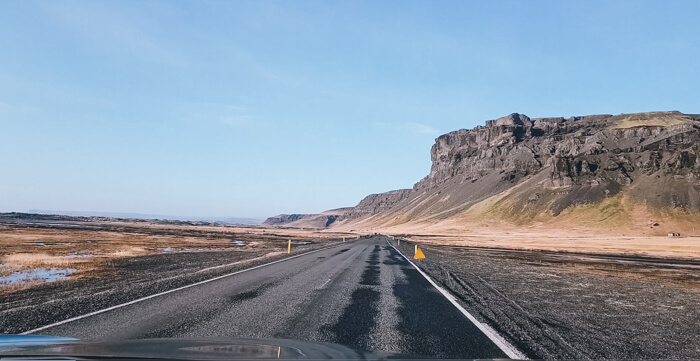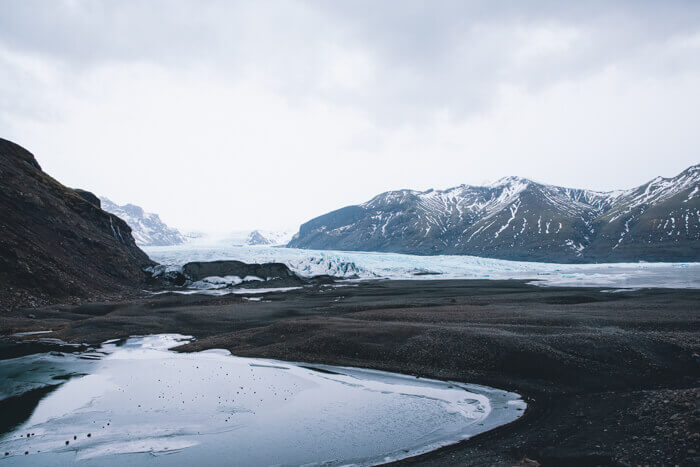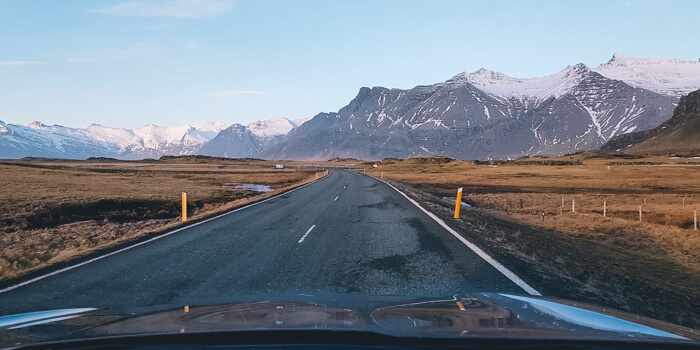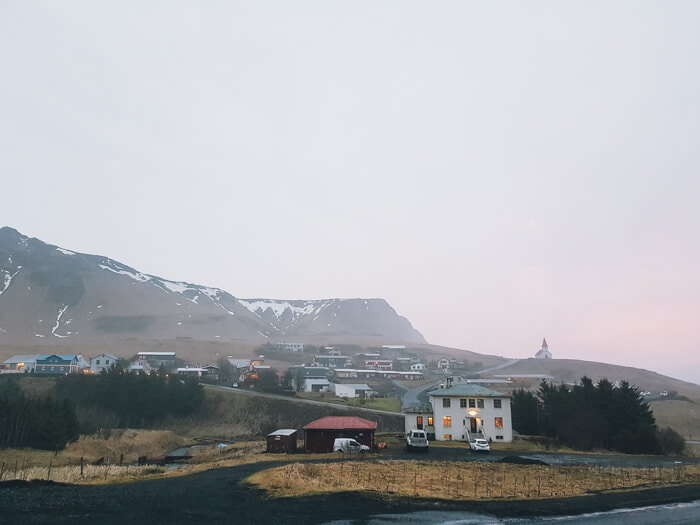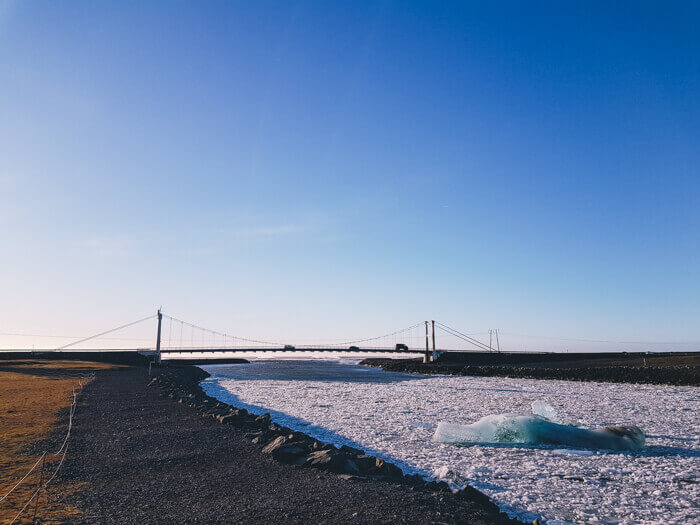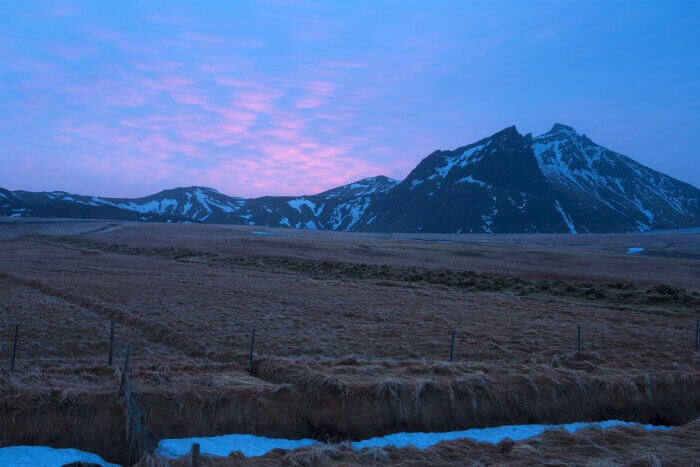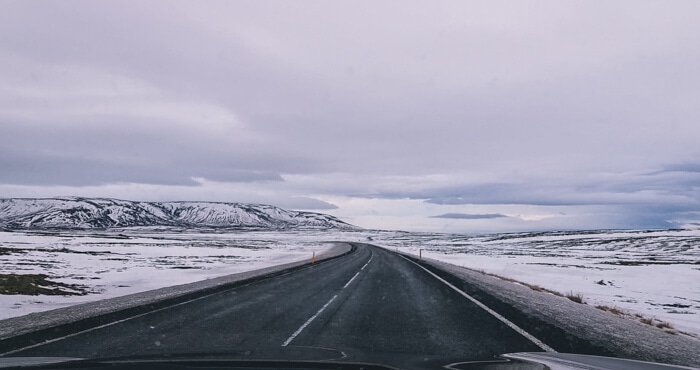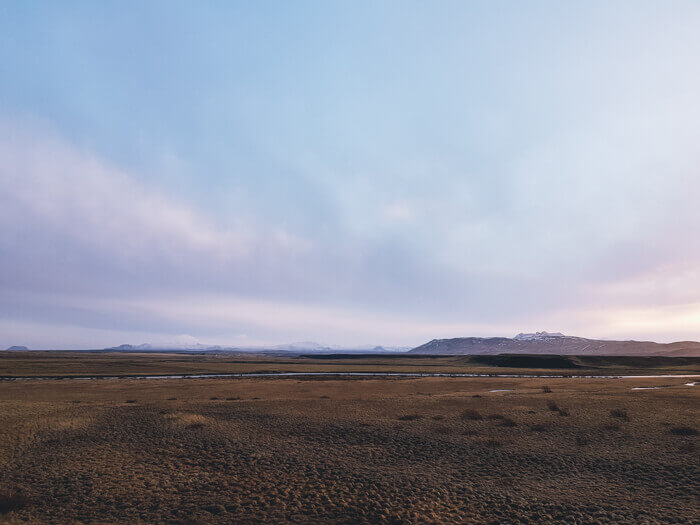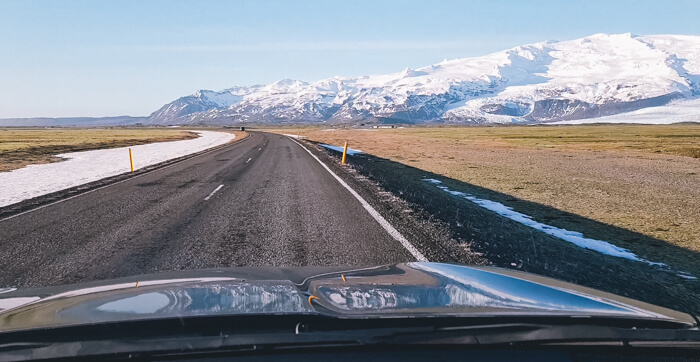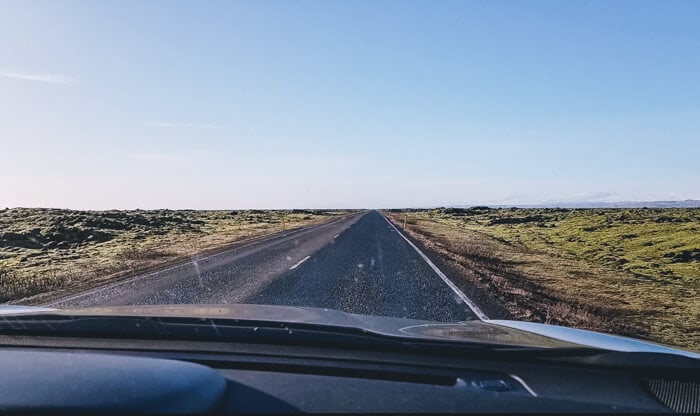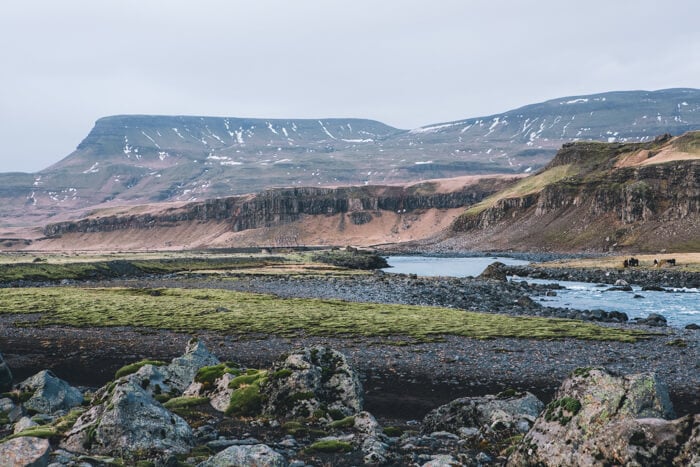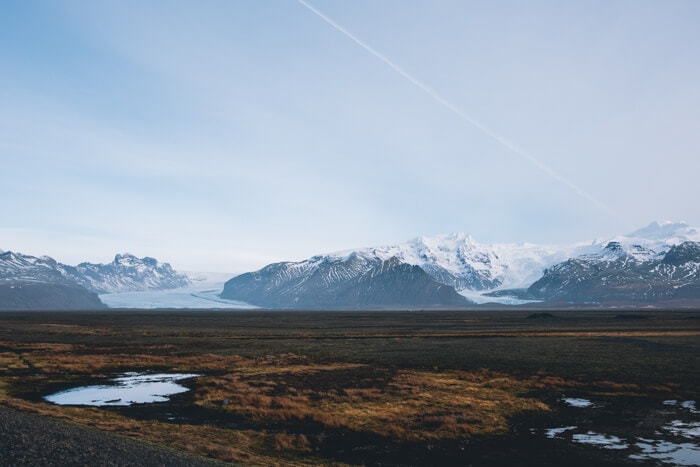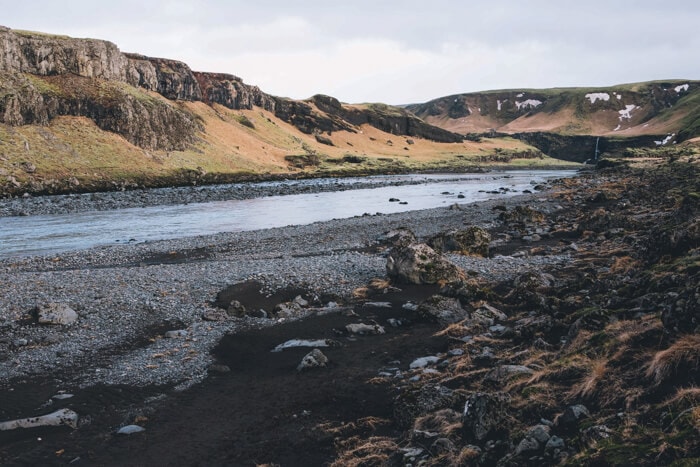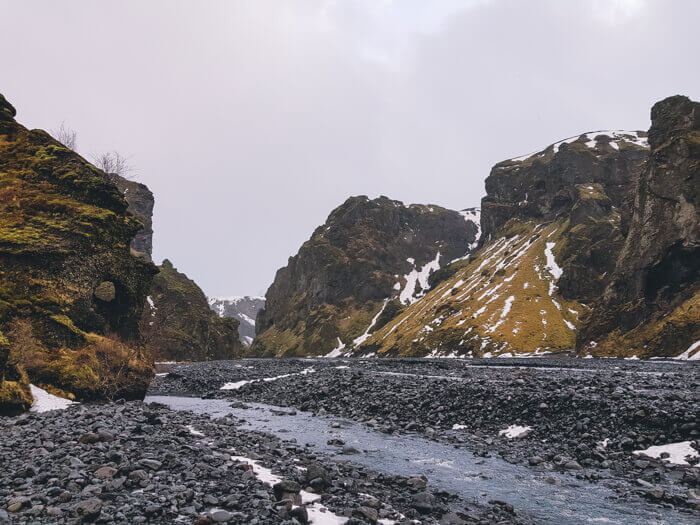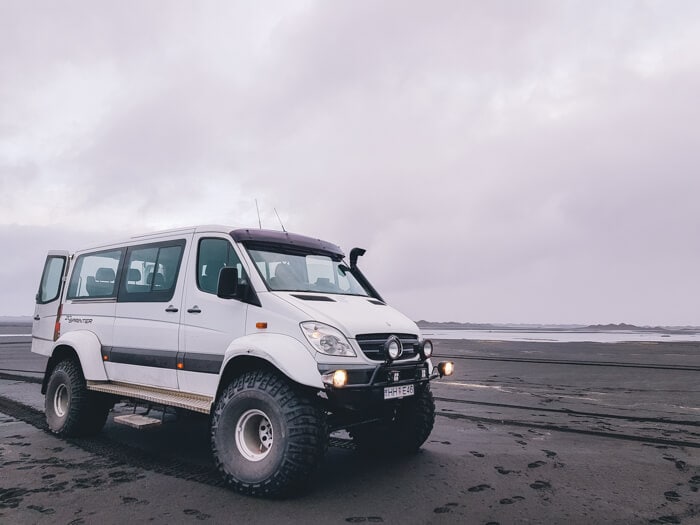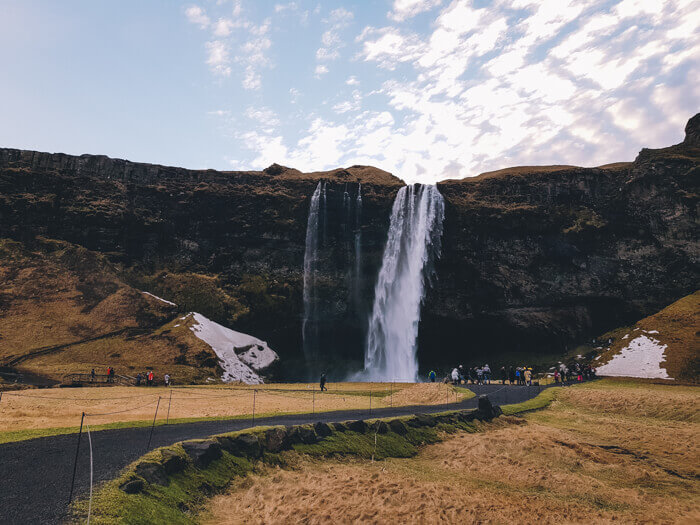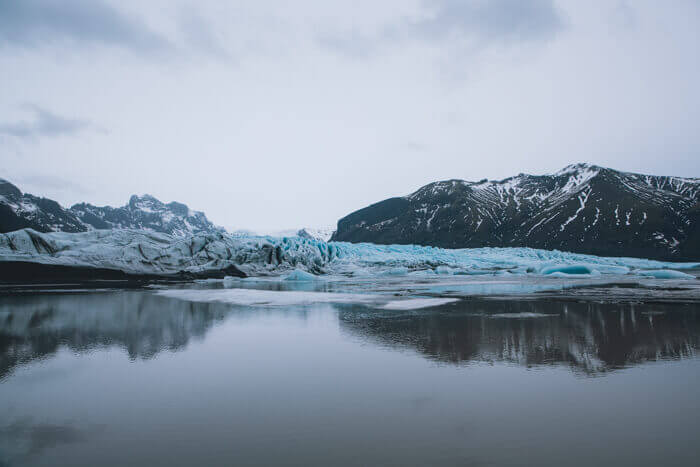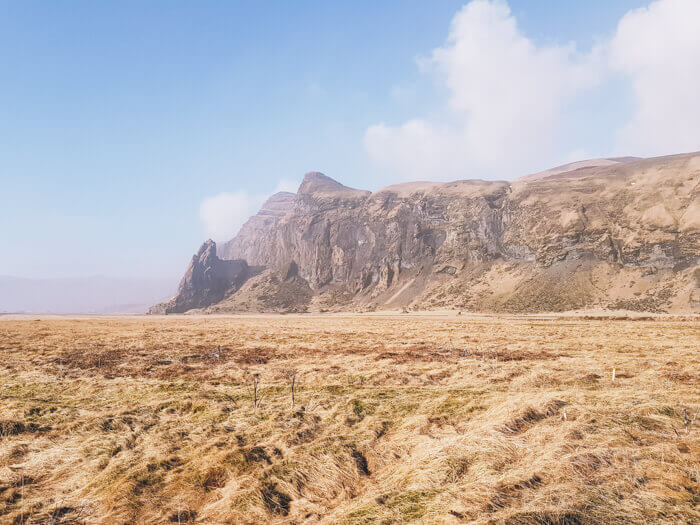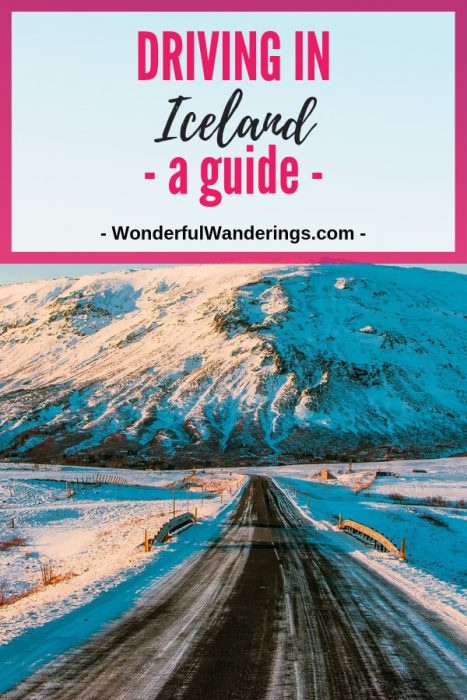When dad and I headed to Iceland for a week in February to road trip along the south coast, we knew we could expect all kinds of weather conditions. The weather in Iceland can change fast, sometimes multiple times a day and can often include snow and ice. That means the driving conditions in Iceland in February can quickly change too.
But we got lucky with our driving in Iceland in winter. When we were there, the weather conditions weren’t too bad. It didn’t freeze once during the day and – unfortunately for the photos – there also wasn’t any snow. Sticking mostly to the main road, the driving conditions weren’t too bad and we didn’t have any trouble driving in Iceland in winter.
I know, however, that the conditions for driving around Iceland in February – or any winter month, for that matter – can be very different at times. Just a week or so before we were there, the island was still covered in snow. You’d expect snowy roads when you go winter driving in Iceland but I guess in this country, you just never know.
To help you prepare for your road trip and winter driving in Iceland, this article covers everything you need to know.
Contents
- What to know when driving in Iceland in February
- Why Visit Iceland in the Winter?
- Is it necessary to have a rental car in Iceland in winter?
- “Am I capable of driving in Iceland in winter?”
- The Iceland driving side
- Quick do’s and don’ts
- What Kind of Licence do You Need to drive in Iceland?
- Renting a car in Iceland in winter
- Winter Visibility in Iceland and Driving in the Dark
- Check the road conditions before you set off
- Check the Weather Conditions in Iceland
- Reaching someone if there’s an emergency
- Drive Slowly and Watch Out for Other Drivers
- Iceland’s Different Roads and What to Expect in Winter
- Stick to the south
- Use Google Maps
- Common Winter Accidents and How to Avoid Them
- Do Not Drive Off-Road or on Closed Roads!
- If You Want an off-road adventure, go on a super jeep tour
- Check where you can get gas
- Cut Your Costs By Getting a Fuel Discount Card
- Driving a Campervan in Winter
- What to Have in Your Car at All Times
- Alternatives to driving in Iceland in winter
- Final tips for driving in Iceland in winter
What to know when driving in Iceland in February
In what follows, I’ll go over some of the most important things you need to know about driving in Iceland in winter, as well as how to make sure you rent a good car for your road trip.
Why Visit Iceland in the Winter?
Let’s start with the most obvious question. If driving in Iceland in winter is harder, why bother doing it at all? Wouldn’t it make more sense to take your Iceland road trip at a different time of year, in the summer maybe? For better weather and better driving conditions, maybe – although that’s never a given in Iceland. But for everything else, winter is the season for planning a trip to Iceland
There are so many reasons why it’s utterly magical to visit Iceland in the winter, but I’ll stick with some of the most compelling.
First of all, it is much cheaper to travel to Iceland in winter. Iceland is not a budget-friendly destination and if you are looking for ways to cut costs, traveling in the winter will help. Prices for hotels, flights, and hire cars can literally halve in some cases. Iceland still won’t be cheap, but it will be much more affordable than in summer.
Aside from price implications, traveling to Iceland in winter gives you the best chance of seeing the iconic Northern Lights as daylight hours are limited, especially in December and January.
The more darkness you have per day, the more likely you are to spot the Northern Lights and the brighter they will shine when you do find them.
Finally, Iceland – and especially the popular south coast – is far less crowded during the winter. There will still be other people around but at some of the lesser-known sights, you have a good chance of having them all to yourself.
Are you convinced about taking a winter driving in Iceland trip yet?
Is it necessary to have a rental car in Iceland in winter?
Well, yes and no. There’s is no rail network in Iceland and public bus transportation is very limited. You can always rent a private driver or join tours but both of these options are more expensive than renting a car and restrict both how much you can see and when you can see it.
For those of you who are interested in joining a few tours, I’ll give you some recommendations at the end of this post. When it comes to planning a proper driving tour of Iceland, though, a rental car is the best way to get around Iceland.
As l mentioned before, driving is the cheapest way to explore the country. Yes, renting a car is expensive and so is filling it up with gas, but a self-drive road trip is cheaper than going on organized tours every day.
Plus, having a car means you can stop wherever you like for food and control your expenses that way as well. Dad and I always ate out for lunch but we also went to the supermarket for a big bag of snacks to keep us going when we didn’t want to stop for a break just yet.
Secondly, the beauty of having your own vehicle is the freedom it gives you. You might have a road trip itinerary planned out, but it is not set in stone. You might see something as you’re driving that makes you want to add a detour into your route. Or you may come across a beautiful view that you want to pull over for and admire or photograph.
This happened to us all the time. We had our road trip itinerary mapped out for the south coast but we stopped just as many times for things we hadn’t planned as for things we had.
Stopping along the side of the road is pretty easy in Iceland too as there’s so little traffic. Just be careful not to slip when it’s icy.
Finally, having a car allows you to work to your own timeframe. In the winter, you will have limited daylight hours and you will want to make the most of them. Having your own vehicle allows you to set off and finish your day as and when you please.
Plus, if you are traveling with friends or a significant other who can also drive, you can take it in turns to drive so no-one gets too bored or tired behind the wheel.
“Am I capable of driving in Iceland in winter?”
Before our trip, I read a lot about driving in Iceland in winter and talked to people who’d already done it to have an idea of what I could expect in terms of the Iceland driving conditions. I feel quite comfortable in the car and bad weather conditions and winter driving don’t tend to scare me.
Dad is the same. He’ll never take unnecessary risks – we did stay in when it stormed heavily one day and there was an official recommendation not to drive – but he’s not afraid to take a bumpy road or drive in the dark in the rain, for example.
Ask yourself this question: are you confident winter driving in your own country? If the streets near your house are iced over, does it make you panic? Do you know what to do if you encounter black ice? Can you keep cool on particularly nerve-wracking icy roads?
If none of those situations stress you out, you’re good to give driving in Iceland in winter a try. And even then: when you rent a car in Iceland, you’ll get a sturdy, high-up 4×4 which for many people will be a much more reliable car in winter driving conditions than what they’re used to driving at home.
As with most things in travel, just use your common sense. If you want to visit something off the main road but you’re feeling uncomfortable driving there, don’t do it. And if you’re traveling with company, discuss beforehand who is comfortable driving the harder parts.
I hope I’m getting across that driving in Iceland in winter is not something only the crazy would do. The Iceland ring road, where you’ll spend 90% of your time driving, is a nice big concrete road where only very bad weather driving conditions will bother you.
It is, however, important to realize that those weather conditions can occur and that when they do, they’re not to be messed with.
Now, let’s move on to the basics.
The Iceland driving side
In Iceland, you drive on the right-hand side of the road. For those of you from the UK and other left-hand driving countries, having everything on the opposite side can be hard to get your head around at first.
If you have never driven on the right side before, find somewhere quiet in Reykjavik where you can have a practice drive around before you hit the open Icelandic roads. Don’t worry if you find it weird at first, it will become second nature in no time.
Quick do’s and don’ts
- The driver and passengers should keep their seatbelt buckled at all times.
- Also keep your headlights on at all times, even during the day.
- Don’t drink and drive.
- Don’t use your mobile phone while driving.
What Kind of Licence do You Need to drive in Iceland?
If you want to rent a car to drive in Iceland, there are some requirements for your driving license. Specifically, your license needs to have a photo, a license number and be printed using Latin script. This means most European, American and Canadian licenses will be fine to use in Iceland.
If your license does not meet these three criteria outlined above, you will need to get hold of an International Driving Permit (IDP). IDPs are cheap and easy to buy. Be sure to check where and how you can buy one in your country as different countries have different service providers.
In addition to your driving license, you need to have one year of driving experience under your belt. This is not a national law, but a policy implemented by most rental agencies. They simply will not rent a car to you unless they think you are a competent driver and one year of experience is usually the minimum they require.
Renting a car in Iceland in winter
What’s the best car to drive in Iceland?
The best car for an Iceland road trip is an SUV with four-wheel drive. The bigger and more powerful the car, the safer you will be. Yes, I know I’ve said the Iceland ring road is a nice big concrete road and we did see regular cars driving on it but we were super glad to have our SUV.
Why?
- Some parking lots have massive potholes.
- We did leave the ring road a couple of times to go see things and practically every other road in Iceland has big potholes.
- A lot of roads in Iceland are gravel. Gravel jumps up as you go through it and a big car has less chance of getting dented and scratched by the rocks.
- The wind can be really strong in Iceland and we had times where we felt it push against the car pretty badly. You want to be in a sturdy car when the weather turns for the worst.
I would also consider getting an automatic. Dad and I both drive an automatic at home so it was a no-brainer for us but I actually got my automatic car after having driven automatic rental cars abroad a few times (and after my trusted Twingo died – may she rest in peace).
Sometimes, an automatic costs a bit more, but the last thing you want to worry about when you’re tackling icy roads or hobbling over potholes is shifting gears. However, some argue that a manual car gives you more control. It’s your call.
All cars have to be equipped with winter tires during winter by law. If there’s lots of snow and ice when you get to Iceland, you might want to opt for studded tires. These will give you even more grip on snowy, icy roads and most rental agencies will be able to help you out with them.
Car insurance
Unfortunately, car insurance in Iceland is a lot more complex than in most other countries in Europe. This has to do with the fact that a lot more things can go wrong driving in Iceland.
I remember my dad telling me about a storm that happened when my mom and he were in Iceland the first time. The wind was so bad that it literally sandblasted the paint off of one side of a car that was parked near a beach. And this was in summer!
You won’t see anything like that happening here in Belgium.
A lot of the things that can happen to your rental car seem to be covered individually in Iceland. There are loads of different types of insurance for things you’ve never even thought about and they all cost extra to add on.
That’s why I highly recommend not just hiring a car in Iceland in winter on the spot but booking one beforehand. That way, you can compare not just their rates but also the kind of insurance packages they offer and look into what you really need.
We worked together with Lagoon Car Rental company on our Iceland car trip. We opted for their Silver Insurance Package – which we luckily didn’t have to use.
First of all, you need to be at least 20 to rent a car, but rental agencies will often charge you a premium to hire and insure a vehicle if you are under 25. It’s annoying but it happens in a lot of places.
CDW
All cars you hire will come standard with Collision Damage Waiver (CDW) insurance. This is required by law and basically means you are covered if you are in a crash. However, the excess of these policies is usually extortionate, meaning you could end up paying the first several thousand dollars before the insurance will kick in.
The next level up from CDW is Super Collision Damage Waiver (SDCW). It sounds fancier but it is pretty much identical to CDW. The only difference is that the excess is much lower. In my opinion, it is worth forking out for this so you’re not totally screwed if you end up crashing.
Optional extras
On top of this basic level of coverage, there are loads of additional insurance policies you can add on. It is up to you to decide whether you get them or not.
Some rental company agents might make it seem like a life or death choice so again: do your research beforehand so you can book exactly what you need and know you don’t need to add anything on when you go and pick up your car. These additional policies include sand and ash insurance, theft insurance, and gravel insurance.
I have to say, we had the Silver Insurance Package with Lagoon which included a bunch of things (so we didn’t have to add insurances on individually) and while they also had a Gold Package, they didn’t even ask us if we wanted to upgrade when we came to pick up our car.
It’s good to know that theft is virtually unheard of in Iceland so don’t worry about that too much. Dad and I left our backpacks in the car practically every time we got out to go and see something. Mine was a regular backpack but dad had his massive camera backpack open on the back seat with lenses and all visible. Nothing happened to it.
Sand and ash insurance will come in handy in the summer, but less so in the winter (depending on where you go).
The policy I recommend investing in is gravel insurance as this covers you from any damage to your windscreen or paintwork as a result of loose, flying gravel. Iceland is full of gravel roads, especially if your road trip plans take you wandering off the beaten track. Tack it on to your insurance policy and thank yourself when you’re cruising along gravel and listening to the sound of tiny rocks pelting the side of your car.
Unless the snow is up high, you’ll hear that sound a lot, trust me.
Our experience of renting a car in Iceland
As I’ve mentioned a few times now, we worked with Lagoon Car Rental for our rental car. While they covered the bill, the whole process of picking up the car, dealing with the on-site agent, and dropping the car back off went completely as usual.
Rental car experiences are one of those things when it’s best if there’s not a lot to say as that meant that everything went the way it was supposed to go and I’m glad I can say that in our case, it did.
We were worried a bit at first because when we landed, the representative from the car rental company who was supposed to pick us up to drive us to the office (it’s not at the airport but a few minutes driving) wasn’t there yet. Things were sorted after a quick call, though, and it turned out we had arrived in “rush hour” and they’d just gone to drop someone else off.
From then on, everything went smoothly. We signed the papers and checked out the car before taking off. There were a few dents that hadn’t been marked on the contract yet so we marked them and Lagoon accepted our changes without even checking them.
We drove off and didn’t need them until we brought the car back a week later. That was just a matter of handing over the keys and waiting for them to check the car for any damage, which there wasn’t.
As we were spending our last night at the Aurora Star Airport Hotel, someone from Lagoon drove us to the hotel and that was it. Needless to say, I’d work with them again.
Also because they were super responsive via email and have a clear booking website plus, their insurance packages make it easy to see what you are and aren’t covered for.
Winter Visibility in Iceland and Driving in the Dark
When we were in Iceland at the end of February, the winter days were already longer. It was light by around 9 a.m. and dark at 6 p.m. If you go earlier in the winter season, though, daylight hours are much more limited. This means you need to plan your days carefully to make sure you make the most of those hours.
We always tried to be at our hotels before it was truly dark and we also made sure we had hotels with restaurants as we didn’t want to go driving in Iceland at night. It wasn’t hard to find hotels with restaurants but sometimes we did arrive when it was already a little dark (there’s so much to see along the south coast!). We usually made it to our accommodation between 5.30 and 6.30 p.m., though.
I didn’t see any street lights along the right road. I’m sure there are some in the bigger towns but I didn’t see street lights anywhere so if you’re driving in Iceland in the winter at night, you’re probably driving in the dark.
In that respect, it’s good to know that you can’t drive really fast anywhere in Iceland. The maximum speed on the ring road is 90 km (60 miles) per hour so while most of the driving distances in Iceland on the south coast between the major sights aren’t that big, it might take you a bit more time.
We found that with the weather conditions we had on our self drive around Iceland, which were good, we always got to places as fast as Google Maps said we’d get there. Take Iceland road conditions into account though, if there’s snow or ice, it can take you longer so always build in a bit of buffer time.
It can also get rather foggy in Iceland, even during the day, so be extra cautious if you have to/want to drive then.
Check the road conditions before you set off
The powers that be in Iceland are well aware that winter driving in their country is difficult. So, they have done everything they can to let you know the road conditions before you set off on your journey.
If you don’t have WiFi or just prefer calling, call 1777 from your hotel or mobile phone and you will get up-to-the-minute information about the road conditions.
Alternatively, keep an eye on the sites en.vedur.is and road.is. The former is Iceland’s weather site which will tell you about storms and other extreme weather (but also about Northern Lights activity!). The latter is Iceland’s road conditions site which will tell you if any roads are closed off.
That day we had a heavy storm in Iceland, we checked these sites regularly to see if things were clearing up. As they advised not to drive that day, we didn’t.
Yes, it’s a day of our trip we had to spend at the hotel but in this case, it was better to be safe than sorry. I don’t think anything would’ve happened to us personally if we’d gone out but with the crazy winds, I’m pretty sure our rental car would have suffered.
Check the Weather Conditions in Iceland
I already mentioned en.vedur.is but there is also another way of keeping an eye on the weather conditions in Iceland. As I mentioned before, the weather in Iceland can change in the blink of an eye, which is both a blessing and a curse. If the weather is really bad, you won’t usually have to wait too long for it to blow over so you can carry on your journey. On the flip side, that blissful sunshine can turn into a storm really fast.
Either way, it’s important to know where it’s headed in case you need to go and find a place to hide.
Throughout Iceland, there are signs on the road that indicate what the weather at certain attractions is like. The first number on the sign is the direction and speed of the sustained wind. For example, N 17 means the wind is blowing in a sustained manner North at 17 meters per second (note that N and S are North and South, but A is East and V is West). If the number goes above 20 that is serious wind and you should stop driving.
The next number is the temperature. If this is around three degrees Celsius or below, pay attention because there is a good chance there will be ice on the roads.
The final number is the speed of the wind gusts. This is different from the sustained wind speed. If the number is green then there is no problem. If it is red, however, you may want to abandon your plan until the number has gone back into green territory.
Most Icelandic drivers say that if this number is 30 or higher they will not drive any further.
If you see the word “Óveður” on the sign, abort the mission because this means storm.
Reaching someone if there’s an emergency
Iceland has an excellent phone network and we were surprised at how many places had good WiFi – but it’s not available everywhere. If you have a phone that will work abroad then great. If you don’t, get yourself an Icelandic SIM card as soon as you land.
There are many stretches of road in Iceland with not a house in sight and you don’t want to get stranded somewhere without being able to contact the authorities or help services.
Also handy to have with you is a mobile hotspot. These only work when you can also get data coverage with your phone but we haven’t found this to be a problem along the south coast.
If you have a mobile hotspot, you’re sure you can get online – and check the weather and road conditions – at any time. Combine that with some credit on your Skype account and you can use your mobile hotspot to make phone calls.
It’s often cheaper than making a regular call on your phone (unless calls are included in your plan) and it’s definitely cheaper when you suffer roaming charges in Europe.
I’ve been using a Solis Wifi hotspot for a few years now. It works both with day passes that you can activate whenever you want and with monthly subscriptions for those who travel a lot. I’ve been using their daily passes not just when I travel outside the EU (no roaming charges for me in the EU) but also as a backup for when I think I’ll go over my phone’s data plan.
Check out Solis Wifi here.
Should something happen and you find yourself in trouble, the emergency services number in Iceland is 112. If you cannot remember that, program it into your phone.
You should also download the free 112 Iceland app, which will send your GPS coordinates to the authorities when something’s wrong. It will also allow you to leave a trail as you travel around during the day so you can be easily tracked by search and rescue.
Drive Slowly and Watch Out for Other Drivers
On the Ring Road and roads away from built-up areas, the speed limit is usually 90 km (60 miles) per hour and 80 km (50 miles) per hour on gravel roads but oftentimes it’s also less and also often, the weather or road conditions will make you go slower.
The speed limit in towns and cities is 50 km (31 miles) per hour.
Stick to these limits. Don’t think that the locals push the pedal and you’ll look like an insecure tourist driving in Iceland like a wuss. They don’t and you won’t. Icelanders are very much aware of the extreme conditions their country bathes in and they adjust their driving accordingly.
During the entire week we were driving around the south coast, we were only passed by a local car twice.
Cars have slipped off the road in the past and have even flipped over onto their roofs when doing so. Don’t act crazy.
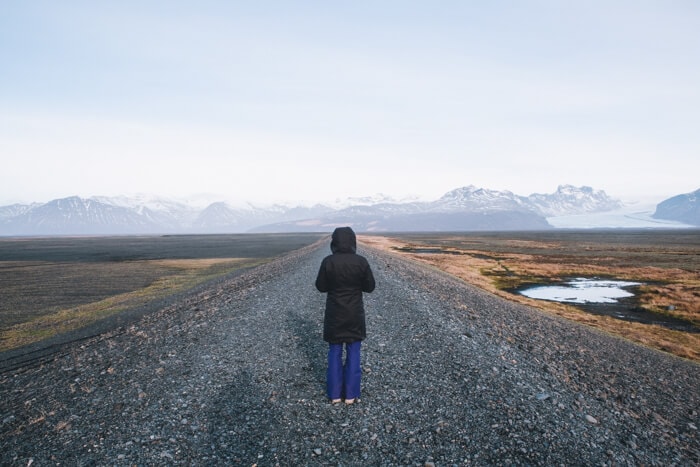
This is a blocked-off street behind a parking lot. I wouldn’t go stand in the middle of a big road.
Another thing you need to be aware of is other drivers on the road – particularly if they are in a rental car. If a car is coming towards you, reduce your speed even more and stay vigilant if they look like they are swerving or out of control.
Now I do also have to say that there aren’t that many cars on the road in Iceland in winter. Of course, we passed quite a few every day, but we also had times where we’d drive for 10 minutes without seeing another vehicle.
There’s no need to worry about heavy traffic when you’re cruising the ring road.
Iceland’s Different Roads and What to Expect in Winter
Iceland has five different kinds of roads, with different road conditions:
- primary roads
- primary highland roads
- secondary roads
- highland roads
- local access roads
Primary roads are what we would think of as highways and connect urban areas. These roads are usually tarmacked and in good condition. The primary road you will most likely come into the most contact with is the famous Ring Road that connects the Golden Circle. No matter what the weather, you can normally count on these roads being accessible.
The primary highland roads and highland roads are designated with an F at the beginning of the road number. They are often referred to as F-roads in Iceland. During the winter it is best to avoid these roads if you can. They are rough and uneven at the best of times so when you throw in ice and high winds they can be deadly. If the weather conditions are really bad, these roads are closed anyway.
Important!
Take note that there are some insurance companies that state that if you drive on F-Roads during winter your policy is invalid. That’s how bad these roads can be so even if the road is open, do not drive along it.
Secondary roads and local access roads tend to be short stretches that connect bigger roads. The conditions aren’t amazing and you definitely shouldn’t be tackling these roads in anything less than a 4×4 or SUV. During the winter, when the weather is really bad, these roads will be closed.
Stick to the south
Before you get all “But that’s where everyone goes, we need to spread out!”, hear me out.
The Ring Road in Iceland is something you’ve probably heard of but don’t necessarily know what it is. Essentially, it is Iceland’s main road and runs around the entire perimeter of the country for a total of 1,332 km. Driving the Ring Road in Iceland is a popular thing to do, but not all-year-long.
While the southern part of the ring road is perfectly doable in winter and most of our Iceland road trip actually followed the Ring Road, the rest of it should be avoided in winter unless you fully understand what you’re getting yourself into.
Road conditions along the other parts of the Ring Road in winter are far from ideal, particularly in North Iceland. Unless you really really want to see the rest of Iceland and know entirely what you’re doing, I’d stick to the south.
You can easily spend more than a week in the south of Iceland and see plenty of things, including the famous Golden Circle (Driving the Golden Circle in winter is perfectly fine, by the way).
We had a blast and we didn’t even visit Reykjavik, where you can spend time in galleries and museums and, of course, go shopping.
Use Google Maps
When I was preparing for this Iceland trip, I kept reading that you should use a GPS but not rely on it. Now, I haven’t used a GPS in years. I always use Google Maps and if I’m worried about not having an internet connection, I’ll download a map of the area I’m going to beforehand so I can use it offline.
We didn’t have any issues relying on Google Maps on our trip but then again, we mainly stuck to the main road and only ventured inland a few times, including to drive the popular Golden Circle.
If other people have reported being led astray by their GPS and sent down roads where they shouldn’t have gone, that’s probably the case, but in all honesty, I trust Google Maps more than some people’s navigation skills :D
What I would recommend and what we also did, is take a paper driving map with a clear legend of what kind of roads are on it and compare how you would drive according to the map with what Google Maps says you should do. In our case, the two always matched.
You can also use your detailed driving map of Iceland if you have a good navigator on board but the downside to this is that it won’t tell you how far and how long you still have to go.
Bringing a regular GPS as a backup is a good idea too. Just make sure you have it all set up beforehand.
Common Winter Accidents and How to Avoid Them
As you can imagine, with the winter roads covered in ice and gale force winds blustering in every direction, road accidents happen regularly, especially when tourists who are not used to the winter driving conditions get behind the wheel.
Here are some common predicaments people driving in Iceland in winter find themselves in and how to avoid them.
1. Mind the doors
One easy way to damage your car is to open the door when there is a really strong wind. It might sound absurd, but when the wind is that strong it can literally tear your door right off your car.
Wind damage is not usually covered by your insurance so if this happens it can be disastrous for your budget and mean game over for your Iceland road trip.
2. Get a grip
Another common accident that occurs on Icelandic roads in the winter is skidding or swerving on ice. If you feel your car start to slide on ice, the instinct is to slam on the brakes. Unless you have anti-lock brakes, this is literally the worst thing you can do and will inevitably lead to you veering off the road.
Instead, brake very gently and steer into the swerve. In other words, turn your front wheels in the direction your back wheels are sliding, otherwise, your car will start spinning and you will lose control completely.
3. Pump it up
Flat tires can cause issues while you are driving so make sure they are fully inflated every time you set off. The condition of some of Iceland’s roads is really bad and your tires will struggle to stay in one piece as they are jolted over gravel and in and out of potholes.
Avoid this by driving really slowly on bad quality roads and making sure at least one person in your group knows how to change a tire.
Note: if you go on a super jeep tour as we did, you’ll notice the driver letting air out of the tires to go off-road and have more grid that way. You shouldn’t be going off-road driving in Iceland with your rental car as it won’t be covered and is even illegal. You should also only let the air out of your tires if you know what you’re doing.
Don’t let the gravel get to you
Speaking of gravel, this can really mess up your car and rental companies are hot on spotting damage caused by gravel. If you think you’ll be fine because the gravel will only affect the underside of your care and they will never notice, think again.
When you bring your car back, they will check under the car for damage and they will be able to tell if you were driving with reckless abandon on gravel roads. Get yourself gravel insurance to cover yourself for this kind of damage.
Deer!
Finally, you should keep an eye out at all times for free-roaming wildlife. Sheep and reindeer can often be found grazing at the side of the road and sometimes they like to cross to the other side for the proverbial greener grass. Stay vigilant and drive slowly, especially if visibility is poor.
If a reindeer runs out in front of you, you won’t have much time to react. With a bit of luck, you will have time to brake or swerve to avoid it. If you hit it you better pray it hasn’t damaged your car too badly – after feeling bad for the deer, obviously.
We didn’t see any animals on the road driving in Iceland in winter, but dad told me him and my mom saw plenty of sheep when they were there in summer.
Do Not Drive Off-Road or on Closed Roads!
Getting off the beaten path is the dream of every adventure traveler and Iceland is a great place to do this. However, do not take this saying literally. Driving off-road is illegal and penalties for doing so are hefty fines (think in the thousands of dollars).
If that’s not enough of a deterrent, Iceland has a fragile ecosystem and driving over it is a surefire way to destroy it. Stick to the roads, there is plenty to see along them anyway.
As for closed roads, if you see a sign telling you a road is closed, it really is closed. Driving along it is both illegal and super dangerous so just don’t do it. If you do and you get caught you will be fined and if you get stuck you’ll pay an arm and a leg for roadside rescue.
If You Want an off-road adventure, go on a super jeep tour
Let me preface this by saying that you cannot hire a Superjeep yourself. You need an experienced driver to drive it for you. If you have the cash to splash you can opt for a private driver, otherwise, you can join onto a Superjeep tour group like we did.
A super jeep is an enormous monstrosity of a vehicle, with huge tires and powerful engines. It’s badass.
Super jeeps can drive across any terrain, including glaciers and rivers. If you want to see the Highlands on your winter driving holiday in Iceland, traveling by super jeep is your only option. As a side note, super jeeps often travel in pairs so that if one gets into trouble, the other can pull it out. How hardcore is that?
We went on a super jeep tour to Thorsmork with Midgard Adventure and had a great trip, it was a blast. Here are some other super jeep tours that come recommended:
1. EYJAFJALLAJÖKULL AND BLACK BEACH SAFARI FROM REYKJAVIK
On this 10-hour tour, an English-speaking guide and expert super jeep driver will take you to see the famous waterfalls Seljalandsfoss and Skógafoss as well as the infamous Eyjafjallajökull. You’ll drive through rivers, admire Iceland’s otherworldly nature and get to spend time on some black beaches.
Book this tour
2. KATLA ICE CAVE AND SUPER JEEP TOUR FROM REYKJAVIK
On this full-day tour, an English-speaking guide will drive you to Kötlujökull Glacier where you’ll get to explore an ice cave. You’ll also get to enjoy the views over the Mýrdalsjökull Ice Cap and take in the sights along the south coast from your super jeep with WiFi included onboard. Crampons for walking on the snow and ice at the glacier are also provided.
Book this tour
If you want the super jeep experience but rather stick to our own schedule, a private driver is the way to go. Hiring one will allow you to remain in control of your own itinerary while having a local driver’s knowledge to boot. Combine the things you want to see with his suggestions and you are guaranteed a great trip and an unforgettable journey.
Check where you can get gas
Normally, both dad and I wait until the last possible moment before we refill our cars. You don’t want to do that in winter in Iceland. There are gas stations all over Iceland so the scarcity of gas providers is not the problem but we found that they weren’t all operational or that some required some kind of membership card.
Unless you plan on driving long distances in Iceland during winter, there’s no need to keep your tank more than half-full. What I would recommend is to start looking for a gas station (Google is great for this) when you only have about 150 km (93 miles) left.
You don’t want to get stuck in bad weather, having to drive like a snail, and then not making it to the next gas station.
Other people advised us beforehand to always keep the tank as full as possible and even to go get gas twice a day but to be honest, I didn’t see the need for that at all. Perhaps if you move away from the south coast, but we already agreed that’s not the best idea ;-)
It is also really important to check what kind of fuel your car needs before you fill it up. Gas is expensive in Iceland and the last thing you want is your hundred dollars of gasoline to be pumped out of your car and thrown away because your car actually needs diesel.
Ask the rental company before you set off and be very careful to use the right pump when you are at the gas station.
Cut Your Costs By Getting a Fuel Discount Card
Olis and Orkan/Skeljungur have fuel discount cards that can save you cash throughout your self-drive in Iceland in winter. The Olis card entitles you to a 5 ISK discount per liter of fuel (which is actually only 0.035 USD but still, it all adds up). It also gives you a 10% discount in the restaurant, free coffee, and free access to the WiFi.
The Orkan/Skeljungur offers a higher discount on fuel with increased fuel purchases over a 30 day period.
It also offers a range of discounts on food, coffee, car products, and a bunch of other stuff.
Most rental cars will have a discount key fob attached to the car keys – ours did. If it doesn’t come with one, ask the rental agency or play it safe and get one yourself one online when you’re planning your South Iceland self-drive.
Driving a Campervan in Winter
A popular choice of vehicle for travelers who visit Iceland is a campervan. We saw so many of these we were truly surprised. I love RV trips but in winter with all that wet gear and the snow boots and everything? I think I’ll pass.
Anyway, the obvious benefit of getting one of these is that you will save money on accommodation. It also saves you time as you don’t need to make return journeys back to a hotel after your excursion.
If you decide to hire a campervan in winter there are a few things you need to know and that I’ve researched for you as we didn’t rent a campervan.
The primary thing you should be aware of is which campsites will be open. As you can imagine, camping in winter is far less popular than in the summer so many campsites close for the season. The best idea is to book your campsites in advance so you can be sure you will have somewhere to stay every night.
On a practical note, you should make sure your campervan is kitted with a heater and that the heater works. This is so important. If you don’t have a heater you will freeze to death in your sleep (probably).
You should also check the pipes and drainage is working properly as the water may freeze in the pipes overnight. Ask the rental agency to show you how to drain the water out of the pipes so it doesn’t freeze.
Also, note that free camping (just pulling up and camping wherever you please) in Iceland is illegal. Make sure you only camp in designated campsites. This is for environmental reasons.
What to Have in Your Car at All Times
You never know what is going to happen when you’re driving in Iceland in the winter. With this in mind, it is a good idea to be prepared for any and every eventuality. The first thing I recommend keeping in your car is a small wad of cash or an extra credit or debit card.
If your card gets damaged or lost and you need gas, this could be a lifesaver.
You should also keep a supply of snacks in your car in case you end up having to wait out a storm for a few hours. Plenty of water, nuts, cereal bars, dried fruit, and some chocolate should do the trick. I can’t tell you how giddy dad got when we went grocery shopping. My mom never buys him candy anymore :D
Some warm clothes and blankets are also useful if you have a long wait in the car for some reason and you don’t want to keep the car heater running or it stops working somehow.
Another useful thing to have is a torch and spare batteries, in case visibility is terrible and you have to change a tire or get out to pee by the side of the road. A headlamp is even better.
As I have already mentioned, a phone with the Iceland 112 app installed and an Icelandic SIM card; and a GPS device or your smartphone with Google Maps on a windscreen or other mount are essential. Also don’t forget to bring a car charger.
Less essential, but quite handy nonetheless, is a dashcam. If you have a Go Pro, you can use this, otherwise, you can find them online for not too much money. It is amazing what has been caught on dashcams in the past and having one may help you out if you’re in an accident that was someone else’s fault and you need to make a claim on the insurance.
And lastly, an ice-scraper. Weirdly enough, these aren’t in all rental cars and you don’t want to have to spend 15 minutes in your car in the morning waiting for the windows to clear before you can get going.
Alternatives to driving in Iceland in winter
If you really don’t feel comfortable driving in Iceland in winter, you have some other options that will allow you to see more than just Reykjavik.
Private driver
The first option is to hire a private driver to do all of the driving for you. This person will have plenty of experience handling Iceland’s icy roads and won’t be fazed by them at all.
This option is the most expensive but allows you to relax and admire the scenery as you are chauffeured from place to place. Your driver might also have some good local suggestions for you for places to see or eat, maybe even the best places to see the Northern Lights.
Short group tours
The second option is to do a group tour. There are dozens of companies offering tours to fit all tastes and timescales. A lot of them leave from Reykjavik but some also leave from other places along the south coast.
You just need to do your research to make sure you book the right thing and with a reputable company. If you are a solo traveler, this could be a great way to meet some people as well.
A great place to find lots of group tours for Iceland is GetYourGuide. This platform shows you reviews from travelers who’ve done the tour before you and also shares who the organizing company is.
Check Iceland tours on GetYourGuide.
Multi-day tours
G Adventures has a wide range of multi-day tours in Iceland, from very active hiking-focused tours to classic tours and even wellness tours. The duration of these tours ranges from 5 to 15 days so you’re bound to find something that fits your schedule. I’ve traveled with them to Romania and had a super fun experience, they do organize great trips.
Have a look at G Adventures Iceland tours here.
Public transportation
Finally, you can rely on public transport and do day excursions from Reykjavik. If you are happy to stay predominantly in one place, you can make the capital your base and simply hop on a bus to a famous sight for a few hours each day.
Mind you: this is not the most time-efficient way to travel and you have to check bus times beforehand as buses are rare and ride infrequently. You don’t want to be stuck at the same waterfall for three hours.
Final tips for driving in Iceland in winter
Be flexible with your travel plans. You never know when the weather will change and everything you planned to do that day goes out of the window. It happened to us but because we had a buffer in our planning, we were fine.
Have plenty of spare money. I know it is annoying having to pay over the odds for something, but sometimes you have no choice. If you get stuck in a blizzard and cannot get to the hotel you booked, you will need to simply check in to the nearest hotel. It means paying twice for accommodation but it is better than spending the night freezing in your car.
Get a 4×4 rental in Iceland and make sure it’s an SUV – they are more expensive but worth every penny for your peace of mind and safety. There are some people that say they are not necessary but in my opinion, they are. The winter roads can get horrible and you’ll feel much more at ease in a big bad car.
Be aware of what time sunrise and sunset will be each day and plan your drives to start and finish in tandem with these events. This requires meticulous planning and back-up planning but it is a necessary evil to maximize your daylight hours and minimize your night driving.
Make sure you have regular travel insurance alongside your rental car insurance. Your rental car insurance should take care of you when something happens on the road but it’s your regular travel insurance that covers you when you slip on ice and break your leg, have a reservation that’s canceled, or notice your luggage didn’t take the same plane there as you did.
I have year-long travel insurance because I travel about 20 times each year but if you only take one or a few trips a year, you can look into getting coverage for just those trips. However long you plan on traveling, check out SafetyWing. They offer super flexible plans that you can even sign up for while you’re already on your trip. On top of that, they were the first travel insurance to cover COVID, and when I got COVID, they reimbursed all of my expenses without making a fuss. Their customer support team is great and I can personally recommend them.
To wrap up, if you’re wondering “How is driving in Iceland in winter?” or “Is driving in Iceland easy?” my answer would be: it depends. We were lucky that the winter weather conditions were great for driving as there wasn’t any snow and it didn’t freeze during our Iceland road trip.
It could have just as well been the opposite and in that case, we probably would have struggled a bit more. However, having seen the roads and how close many of the natural sights on the south coast are to the main road, I believe driving the south coast of Iceland in winter by yourself is perfectly fine.
Having read this post, you’ve done your research. Now you just need to go, be careful, and have fun.
PIN FOR LATER

